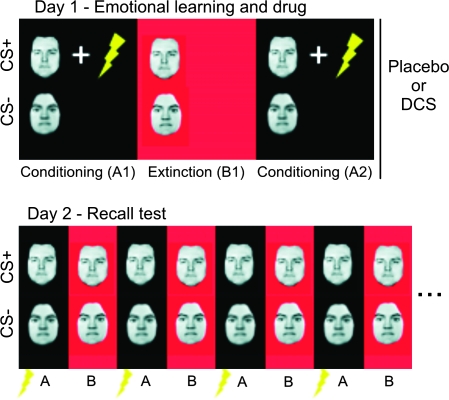Figure 1.
Fear and extinction recall paradigm. On day 1, subjects (n = 31 healthy female volunteers) were fear conditioned to a CS+ (a face) through multiple pairings with an UCS (electric shock) in context A (conditioning context, block A1). Fear responses were then extinguished in context B (extinction context, block B1) through multiple CS+ presentations in the absence of the UCS. To ascertain retention of fear memories until a recall test 72 h later (see below), conditioning was repeated in a further block (A2). As a control for nonassociative effects, we also employed a nonpredictive CS− (a face of opposite gender) that was never paired with the UCS and presented intermixed with the CS+. Contexts were defined by screen color and auditory input. It was assumed that this procedure would create a CS-associated fear memory. Based on an earlier study by our group (Kalisch et al. 2006a), it was also assumed that the procedure would create an (extinction) context-dependent extinction memory. Learning was followed by administration of either placebo (n = 16) or 500-mg DCS (n = 15). On day 2 (72 h later), CSs were presented in both contexts A and B to test for CS-evoked fear and extinction memory recall, respectively. To this purpose, each context was presented 16 times in alternating order. Recall of fear memory in context A on day 2 was facilitated by additionally presenting 1 unpaired shock at the beginning of each context A block, thus again firmly associating context A with the UCS. The task was a speeded gender decision task in response to the face stimuli. Gender of faces and conditioning and extinction contexts were counterbalanced between groups. The design was randomized, double blind, and between subject. Flash denotes electric shock.

